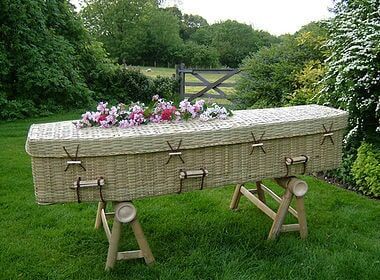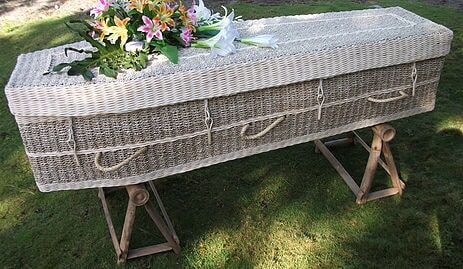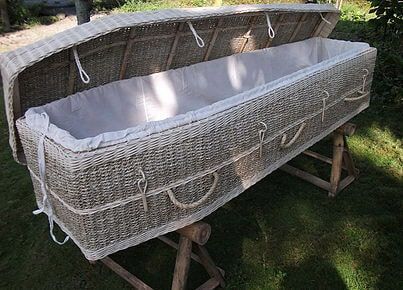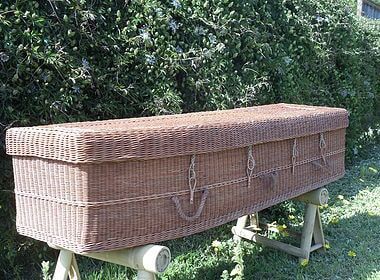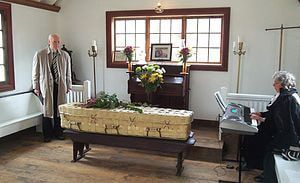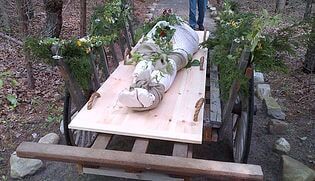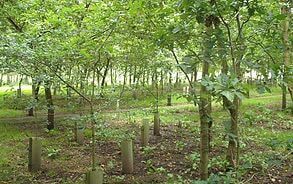GREEN BURIALS
Green Burials, PA
Green burial, also known as natural burial, is an environmentally-conscious alternative to traditional burial practices. It involves interring a body in a biodegradable casket or shroud, allowing the body to decompose naturally and return to the earth, minimizing the environmental impact associated with embalming chemicals and non-biodegradable materials commonly used in conventional burials.
Steelmantown Cemetery "Eternally Green"
Steelmantown Cemetery is about one hour from Morrisville, Pennsylvania. It has a natural beauty that will leave you in amazement.
Price List For Green Burial Caskets
Prices DO NOT Include Shipping
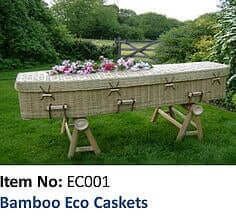
74" x 23" x 18" $1370
71" x 21" x 18" $1370
69" x 20" x 18" $1370
64" x 18" x 18" $1320
55" x 16" x 18" $565 (Child)
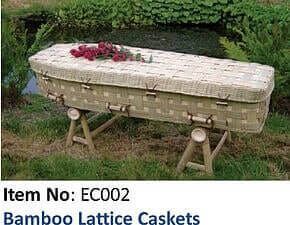
80" x 24" x 18" $1700
74" x 23" x 18" $1600
71" x 21" x 18" $1600
69" x 20" x 18" $1600
67" x 18" x 18" $1540
64" x 18" x 18" $1460
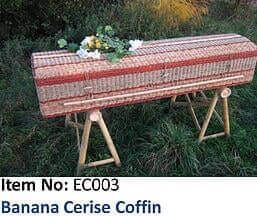
84" x 26" x 18" $1830
76" x 24" x 18" $1830
71" x 21" x 18" $1810
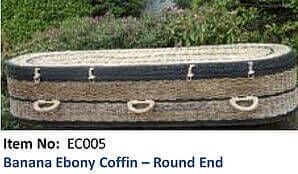
84" x 26" x 18" $1830
76" x 24" x 18" $1830
71" x 21" x 18" $1810
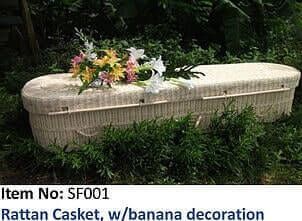
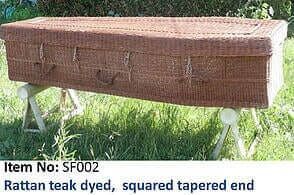
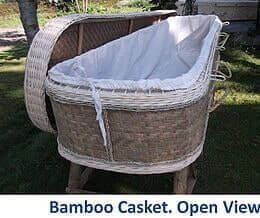
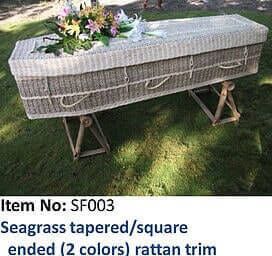
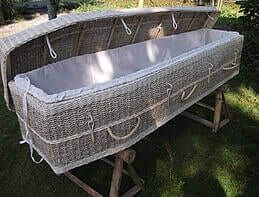
Seagrass tapered/square ended (2 colors) rattan trim - Open View
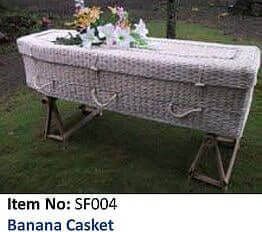
- Green burial with minimum casket $4,605.00
- Green burial with casket provided by purchaser $3,235.00
- Green burial with casket selected from our funeral home (in addition to cost of casket) $3,235.00
- Additional items that you, the family may request…
- Disinfect remains and set features for viewing $ 175.00
- Use of funeral home for private viewing $ 750.00
- Refrigeration $ 80/day
- Nursing home/residence removal $ 100.00
Direct burial casket ranges from $1,370 - $1,830 (prices do not include shipping – shipping can range between $100.00 and $200.00 for delivery in 4-5 days.
We recommend Steelmantown Cemetery in South Jersey as the nicest natural, embalming free green cemetery.
Frequent Questions
Click on the questions below to reveal each respective answer.
-
What is green burial?
Green burial is a way of caring for the dead with minimal environmental impact that furthers legitimate ecological aims such as the conservation of natural resources, reduction of carbon emissions, protection of worker health, and the restoration and/or preservation of habitat. How does green burial differ from conservation burial? Conservation burial is a term coined by the Green Burial Council at the 2005 Land Trust Alliance National Rally. The concept calls for a cemetery's adherence to a number of protocols to ensure that burials never degrade an ecosystem and, where possible, facilitate ecological restoration. It requires that surveys (biological, geological, hydrological) be done to determine where burial should and should not take place on a piece of land, and at what density. Most significantly, conservation burial requires that an established, independent conservation organization, most often a land trust, serve as steward of this land and be willing to hold a conservation easement. This legally enforceable instrument, which runs with the land, guarantees that the standards for conservation burial, set forth by the Green Burial Council, will be upheld in perpetuity.
-
What does it mean if a cemetery is Green Burial Council certified?
GBC certification allows consumers to be able to distinguish between the three levels of green burial ground and understand that each has a different set of standards. It requires cemetery operators commit to certain degree of transparency, accountability and third party oversight. And it prevents future owners from going back on whatever ecological or aesthetic promises have been made in the past -- from limitations on burial density that protect a local ecosystem to prohibitions against the use of monuments that would negatively impact a viewshed.
-
What's wrong with embalming?
The Council doesn't think any end-of-life ritual, form of disposition, or mode of post-mortem preparation is "wrong." We only want to ensure that services and products are available to people who wish to minimize the environmental impact of their last act. Embalming fluid is usually comprised of the carcinogen chemical formaldehyde, which has been proven to pose health risks in funeral homes. A study by the National Cancer Institute released in late 2009 revealed that funeral directors have a much higher incidence of myeloid leukemia. Fortunately, there are now several formaldehyde-free embalming fluids, including one made entirely of nontoxic and biodegradable essential oils, which recently earned the GBC seal of approval. The sanitation and preservation of a corpse can almost always take place without the use of chemicals, as is done in just about every nation in the world -- with the exception of the US, Canada and a half-dozen others.
-
Since burial vaults are made from concrete, shouldn't they be considered green?
While the concrete and metal in vaults may be considered "natural" to some, the manufacturing and transporting of vaults uses a tremendous amount of energy and causes enormous carbon emission. In this US, vault manufacturing requires the production of 1.6 tons of reinforced concrete. Vaults are not required in GBC-approved hybrid burial grounds, and they are prohibited in Council-certified conservation and in natural and environmentally low-impact burial grounds.
-
How do I know that a particular product is suitable for a green burial?
The GBC believes a casket, urn, or shroud is suitable for a green burial if it's made from materials/substances that are nontoxic and readily biodegradable. We also require that these products not be made from materials that are harvested in a manner that unnecessarily destroys habitat, as is the case with certain types of sea grass.
-
Doesn't cremation create a lot of pollution?
Cremation uses far fewer resources than almost any other disposition option but it certainly has an environmental impact. Cremation burns fossil fuels, and some older cremation facilities can use significantly more energy compared to newer ones. Mercury is also emitted when a person with dental amalgam fillings is cremated, but effective filtration devices that can fully mitigate mercury pollution should come on the market in the very near future. While no standards yet exist that allow consumers to determine which cremation retorts produce the most pollution and carbon emissions, there are several things that can be done to “green up” cremation such as recycling medical parts, and making a contribution to a carbon fund.
-
Why don't you certify cremation disposition programs?
While a cremation disposition program may provide benefit by setting ecologically responsible standards for memorial reefs and scattering grounds, the amount of resources and effort required to responsibly establish and manage such programs come at the cost of utilizing resources to further the organization's main objectives: to encourage environmentally sustainable deathcare through its funeral home and product compliance program, and to preserve natural areas through green burial via its burial compliance program. Accordingly, we currently do not have a cremation disposition certification program.
-
What is a home funeral and how does it differ from a home burial?
Home funerals, which allow for families to care for a decedent and all aspects of a funeral at home, were quite common in the US up until the mid-20th century. A family can facilitate a home funeral in almost every state, or do it with the assistance of a licensed funeral director. Most all GBC-approved funeral homes accommodate families wanting home funerals. A home burial is an alternative to disposition in a cemetery. It's allowed by almost all counties, but most require a minimum number of acres and often the filing of a plat map with the planning department.
-
Are green burials legal in PA?
-
Can you be buried on your own property in Pennsylvania?
The Pennsylvania Department of Health has no laws against private burials, but local governing bodies may have rules. Before you bury a body on private property or establish your family cemetery make sure that the land is not in violation with any zoning regulations for burial sites.
-
What is considered a green burial?
Green burial is a more sustainable alternative to traditional burials. It's environmentally friendly, saves on costs of disposing bodies in the ground or cremating them with chemicals that are not healthy for anyone nearby, it doesn't use fancy caskets which can make an area look ugly during construction because they take up so much space when buried - all without compromising safety! They're placed in biodegradable containers that decompose fully returning nutrients back into nature for future use by plants, life animals and people alike!
-
How deep are you buried in a green burial?
Generally, the ideal 3.5 ft - 4ft burial is required to guarantee optimal decomposition conditions and prevent animals from smelling anything in your grave. This guarantees an 18 - 24 inch smell barrier that not only prevents animals and two or four legged creatures from smelling anything, but also keeps the scent of decomposing remains at bay. The top of the grave is made level with displaced soil placed on it. The depth that this creates makes for an even more impressive organic, doubling its original size!
-
Can I be buried without a coffin?
There are no state laws in the U.S requiring the use of a casket for burial or cremation, although some people choose to carry them out and others avoid using anything but an open grave with few ceremonies surrounding their loved one's passing like floral arrangements around headstones where they're laid on top. A person can be directly interred in the earth, or they might choose to use a vault without caskets. Burial vaults come with an inherent requirement that you do not bury people if there's no space for one because of cost and availability but it is entirely up to them which method they would like their loved ones body presented with when buried side by side with other deceased family members.
-
What are blended funerals?
Funerals that offer a green burial or home funeral option for those who want to be environmentally conscious. Funerals that combine this practice with home funeral or green burial may involve hiring a professional director for certain aspects of care, such as obtaining paperwork necessary after death has occurred. Some people are avoiding funeral homes because they offer more services than what's available in their area. Blended funerals can help these families find a solution for all their needs, especially if certain options aren't offered where you live! All GBC-approved funeral homes can accommodate families who want a more personal experience.
-
What is a home burial?
A home burial is a great way to memorialize your loved ones and keep them close by. Home burials are legal in all but Arkansas, California, Indiana & Louisiana with some states having restrictions on where you can have the ceremony. Home burials are a great way to be able to bury your loved ones in the comfort and safety of their own home. Whether they're an ancestor that has meant something special or someone close who deserves nothing less than respect, you can lay them down next time when it's most appropriate for each individual person.
-
How is a grave liner different from a vault?
A grave liner is an important part of the burial process. They cover most sides and tops, acting like boxes for coffins that need them. Cemeteries require them both because they avoid any possibility for subsidence caused by settling or shifting earth, but it’s not required in green burials either way since these materials do not biodegrade naturally like most other thrown-upon substances (including plastics) would - meaning more nonrecyclable materials on soil.
-
What is required for a shroud burial? And are burial garments required?
Burial shrouds have been used by various cultures and religions for centuries. Burials are usually brief, with only the body wrapped in a biodegradable cloth to cover it before being lowered into its final resting place. A casket is not always used for a shroud burial, but the main determining factor is usually written into their bylaws. The decision to include a casket in your burial is completely up to the cemetery's policies and guidelines. Some people like having one because it makes things easier, but others don't mind without them if their religion requires that type of preparation for eternity as well!
-
How does a shrouded body get carried to the grave?
A variety of vehicles are available to move bodies, including retrofitted golf carts and wagons. Some families choose a processional with pall bearers on shoulders or carrying handles for shroud burials. Some families choose to conduct their own processions with pall bearers or carrying handles on boards used during burials of the dead if they are not traditional funeral services in nature.
Need Assistance or Have Questions? Call Us Today, We Are Available 24/7 | 215-295-7725
MENU
A Year of Grief Support
Sign up for one year of weekly grief messages designed to provide strength and comfort during this challenging time.
Please wait
Verifying your email address
Please wait
Unsubscribing your email address
You have been unsubscribed
You will no longer receive messages from our email mailing list.
You have been subscribed
Your email address has successfully been added to our mailing list.
Something went wrong
There was an error verifying your email address. Please try again later, or re-subscribe.

